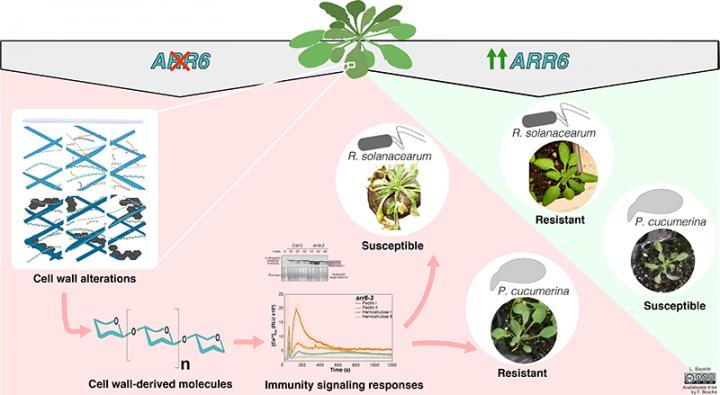Cell wall research reveals possibility of simple and sustainable method to protect crops

Arr6 cell wall alteration diagram. Credit: Antonio Molina
Scientists are always looking for ways to improve crop disease resistance by advancing their knowledge of the plant immunity system.
In a study published recently, a group of biologists discovered that cell wall extracts from immune active plants could be used by agriculture companies to develop sustainable treatments that help crops protect against pathogens and pests.
Antonio Molina and his research group at Centro de Biotecnología y Genómica de Plantas in Spain aimed to understand the role of the cell wall in the regulation of plant resistance responses to pathogens.
To do that, a collection of mutants with alterations on their cell walls composition/structure were selected and their resistance to different pathogens analyzed.
“Our results support the potential use of formulations based on cell wall-derived molecules that trigger immune responses,” explained Antonio Molina.
“The use of such formulations could present a simple, sustainable, and effective treatment to protect crops against losses.”
The research focused on the Arabidopsis Response Regulators 6 (ARR6) gene, which has been shown to be involved in the responses mediated by the plant hormones known as cytokinins.
Molina and his colleagues showed that ARR6 is actually a regulator of cell wall composition and of the disease resistance responses of the model plant Arabidopsis thaliana against different pathogens causing important crops diseases.
This discovery reinforces the role the plant cell wall in the modulation of specific immune responses.
“We have identified a pectin-enriched cell wall fractions of arr6 mutant that has an enhanced activity in triggering defense response in Arabidopsis plants,” said Molina.
“This finding indicate that the cell walls of arr6 mutant have a differential composition than that of wild-type plants, and that arr6 walls might contain molecules which could contribute to the differential resistance response to fungi and bacteria observed in these plants. This points to an interesting, novel interaction between wall composition, innate immunity signaling and disease resistance.”
Molina's research group was most surprised to find that the differential resistance responses activated in arr6 plants were not the “classical” disease resistant responses characterized so far, indicating that novel defensive mechanisms associated with alteration on cell wall composition will be discovered, like the immune responses described in their article.
###
Read more in “Arabidopsis Response Regulator 6 (ARR6) Modulates Plant Cell-Wall Composition and Disease Resistance,” published in the MPMI journal.
About Molecular Plant-Microbe Interactions (MPMI) Molecular Plant-Microbe Interactions® (MPMI) publishes fundamental and advanced applied research on the genetics, genomics, molecular biology, biochemistry, and biophysics of pathological, symbiotic, and associative interactions of microbes, insects, nematodes, or parasitic plants with plants.
About Centro de Biotecnología y Genómica de Plantas (CBGP)
The Centro de Biotecnología y Genómica de Plantas (CBGP) is a joint research centre of the Universidad Politécnica de Madrid (UPM) and the Instituto Nacional de Investigación y Tecnología Agraria y Alimentaria (INIA), that is located in Madrid (Spain). CBGP (UPM-INIA) holds the recognition of Centre of Excellence Severo Ochoa.
Follow on Twitter @CBGP_Madrid and visit
http://www.
Media Contact
More Information:
http://dx.doi.org/10.1094/MPMI-12-19-0341-RAll latest news from the category: Agricultural and Forestry Science
Newest articles

Pinpointing hydrogen isotopes in titanium hydride nanofilms
Although it is the smallest and lightest atom, hydrogen can have a big impact by infiltrating other materials and affecting their properties, such as superconductivity and metal-insulator-transitions. Now, researchers from…

A new way of entangling light and sound
For a wide variety of emerging quantum technologies, such as secure quantum communications and quantum computing, quantum entanglement is a prerequisite. Scientists at the Max-Planck-Institute for the Science of Light…

Telescope for NASA’s Roman Mission complete, delivered to Goddard
NASA’s Nancy Grace Roman Space Telescope is one giant step closer to unlocking the mysteries of the universe. The mission has now received its final major delivery: the Optical Telescope…



